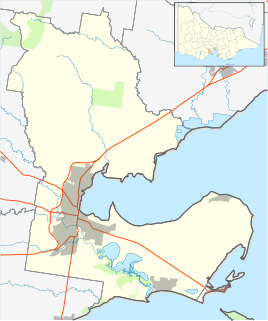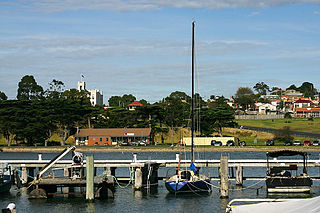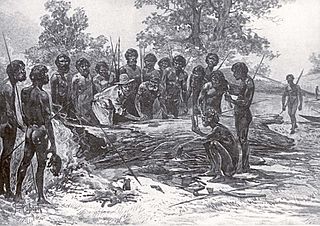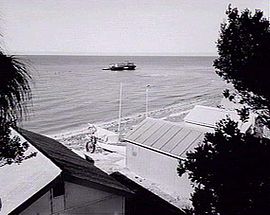
This article describes the history of the Australian colony and state of Victoria.

Port Phillip , or Port Phillip Bay, is a horsehead-shaped enclosed bay on the central coast of southern Victoria, Australia. The bay opens into the Bass Strait via a short, narrow channel known as The Rip, and is completely surrounded by localities of Victoria's two largest cities — metropolitan Greater Melbourne in the bay's main eastern portion north of the Mornington Peninsula, and the city of Greater Geelong in the much smaller western portion north of the Bellarine Peninsula. Geographically, the bay covers 1,930 square kilometres and the shore stretches roughly 264 km (164 mi), with the volume of water around 25 cubic kilometres (6.0 cu mi). Most of the bay is navigable, although it is extremely shallow for its size — the deepest portion is only 24 metres (79 ft) and half the bay is shallower than 8 m (26 ft).

William Buckley was an English convict who was transported to Australia, escaped, and was given up for dead while he lived in an Aboriginal community for many years.

The Mornington Peninsula is a peninsula located south of Melbourne, Victoria, Australia. It is surrounded by Port Phillip to the west, Western Port to the east and Bass Strait to the south, and is connected to the mainland in the north. Geographically, the peninsula begins its protrusion from the mainland in the area between Pearcedale and an area north of Frankston. The area was originally home to the Mayone-bulluk and Boonwurrung-Balluk clans and formed part of the Boonwurrung nation's territory prior to European settlement.

Queenscliff is a small town on the Bellarine Peninsula in southern Victoria, Australia, south of Swan Bay at the entrance to Port Phillip. It is the administrative centre for the Borough of Queenscliffe. At the 2016 census, Queenscliff had a population of 1,315.

John Batman was an Australian grazier, entrepreneur and explorer, best known for his role in the founding of Melbourne.

Barwon Heads is a coastal township on the Bellarine Peninsula, near Geelong, Victoria, Australia. It is situated on the west bank of the mouth of the Barwon River below Lake Connewarre, while it is bounded to the west by farmland, golf courses and the ephemeral saline wetland Murtnaghurt Lagoon. At the 2016 census, Barwon Heads had a population of 3,875.

Portarlington is a historic coastal township located on the Bellarine Peninsula, 28 km from the city of Geelong, in the state of Victoria, Australia. It has a diverse population which includes a wide range of ethnic backgrounds, a high proportion of retirees, and a large seasonal holiday influx. The gently rising hills behind the town feature vineyards and olive groves, and offer spectacular panoramic views across Port Phillip Bay. Portarlington is a popular family holiday destination and a centre of fishing and aquaculture (mussels). At one time the town claimed the largest Caravan Park in the Southern Hemisphere, although the size has reduced considerably in recent decades. With direct ferry links to the city of Melbourne Portarlington also serves as a gateway to the historic towns and surf beaches of the Bellarine Peninsula.

St Leonards is a coastal township near Geelong, Victoria, Australia, at the eastern end of the Bellarine Peninsula and the northern end of Swan Bay. Situated 33 kilometres (21 mi) east of Geelong, St Leonards was a filming location for the Australian television series SeaChange.

The Bellarine Peninsula is a peninsula located south-west of Melbourne in Victoria, Australia, surrounded by Port Phillip, Corio Bay and Bass Strait. The peninsula, together with the Mornington Peninsula, separates Port Phillip Bay from Bass Strait. The peninsula itself was originally occupied by Indigenous Australian clans of the Wathaurong nation, prior to European settlement in the early 19th century. Early European settlements were initially centred on wheat and grain agriculture, before the area became a popular tourist destination with most visitors arriving by paddle steamer on Port Phillip in the late 19th century.

Batman's Treaty was an agreement between John Batman, an Australian grazier, businessman and coloniser, and a group of Wurundjeri elders, for the purchase of land around Port Phillip, near the present site of Melbourne. The document came to be known as Batman's Treaty and is considered significant as it was the first and only documented time when Europeans negotiated their presence and occupation of Aboriginal lands directly with the traditional owners. The so-called treaty was implicitly declared void on 26 August 1835 by the Governor of New South Wales, Richard Bourke.

The city of Melbourne was founded in 1835. The exact circumstances of the foundation of Melbourne, and the question of who should take credit, have long been matters of dispute.
The Wathaurong nation, also called the Wathaurung,Wadawurrung and Wadda Wurrung, are an Aboriginal Australian people living in the area near Melbourne, Geelong and the Bellarine Peninsula in the state of Victoria. They are part of the Kulin alliance. The Wathaurung language was spoken by 25 clans south of the Werribee River and the Bellarine Peninsula to Streatham. The area they inhabit has been occupied for at least the last 25,000 years.

Joseph Tice Gellibrand was the first Attorney-General of the British colony of Van Diemen's Land where he gained notoriety with his attempts to establish full rights of trial by jury. He became an integral part of the Port Phillip Association, producing the Batman Treaty in an attempt to obtain extensive land-holdings from the local Aboriginal people around Port Phillip. He was also later part of an ill-fated expedition into the region west of Geelong where he disappeared and was assumed to have been killed by Aboriginal people in the Otway Range.
The Port Phillip Association was formally formed in June 1835 to settle land in what would become Melbourne, which the association believed had been acquired by John Batman for the association from Wurundjeri elders after he had obtained their marks to a document, which came to be known as Batman's Treaty.
The 30-ton sloop Rebecca was launched in 1834, built by Captain George Plummer at his boatyard on the banks of the Tamar River at Rosevears, Van Diemen's Land (Tasmania).
The murnong or yam daisy is any of the plants Microseris walteri, Microseris lanceolata and Microseris scapigera, which are an important food source for Indigenous people in Australia.
Melbourne Day is an annual celebration to mark the founding of Melbourne in Victoria, Australia, on 30 August 1835.

The Powlett River is a perennial river of the Western Port catchment, located in the West Gippsland region of the Australian state of Victoria.
The Mount Cottrell massacre involved the murder of an estimated 10 Wathaurong people near Mount Cottrell in the colony of Victoria in 1836, in retaliation for the killing of two European settlers.


















